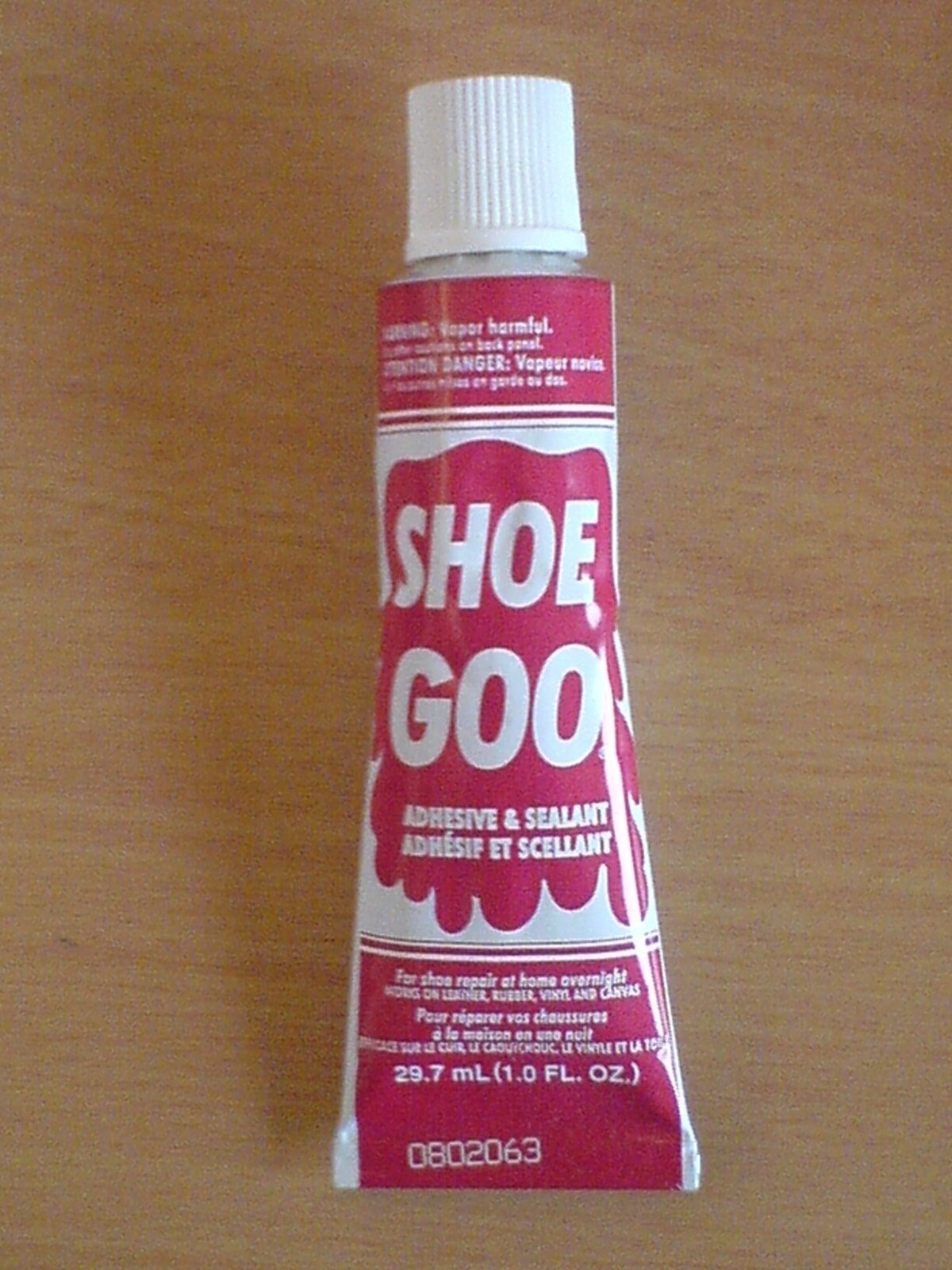Shoe Goo and Rubber Cement are both adhesive products used for repairing shoes.
Contents
Composition
In the world of shoe repair and craftsmanship, Shoe Goo and Rubber Cement are two popular products that are often used for mending and bonding shoes.
Understanding their composition is crucial in determining their effectiveness for different shoe repair tasks.
Shoe Goo Components
Shoe Goo is a strong adhesive and sealant designed specifically for repairing and protecting footwear. It is composed of a unique blend of polyurethane and other proprietary compounds.
This combination gives Shoe Goo its superior bonding strength and flexibility, allowing it to effectively mend various types of shoe materials, including rubber, leather, vinyl, and canvas.
Rubber Cement Components
Rubber Cement, on the other hand, is formulated with synthetic rubber as its primary component, along with solvents and resins.
The rubber component provides the adhesive properties, while the solvents and resins contribute to its ability to form a strong and flexible bond.
Rubber Cement is commonly used for temporary shoe repairs and is known for its quick-drying nature.

Adhesion Strength
Shoe Goo and rubber cement are both popular adhesives used for repairing and attaching various types of shoe materials. When considering their adhesion strengths, it is essential to understand their differences and the best uses for each product.
Difference In Adhesion Abilities
Shoe Goo is known for its superior adhesion strength, especially on flexible materials such as rubber and vinyl. Its ability to bond and fill gaps makes it ideal for repairing worn-out soles and toe caps.
On the other hand, rubber cement offers a strong initial bond but may not withstand heavy stress or repeated flexing as effectively as Shoe Goo. However, it excels in bonding non-flexible materials like leather and wood.
Best Uses For Each Product
Shoe Goo is best suited for repairing athletic shoes, hiking boots, and other footwear exposed to constant bending and stretching. Its durable adhesion makes it an excellent choice for securing detached soles and reinforcing seams.
In contrast, rubber cement is more appropriate for attaching insoles, heel grips, and repairing non-flexing parts of shoes. It provides a quick, strong bond for various materials, including leather, wood, and cardboard.
Flexibility And Durability
The comparison between Shoe Goo and Rubber Cement in terms of flexibility and durability is crucial for selecting the right adhesive for your shoe repair needs.
Flexibility Comparison
Shoe Goo offers exceptional flexibility, with the ability to bend and stretch without cracking. In contrast, Rubber Cement may not provide the same level of elasticity.
Longevity And Wear Resistance
When it comes to longevity, Shoe Goo demonstrates remarkable durability over time. On the other hand, Rubber Cement may show signs of wear more quickly due to its composition.
Application Process
In this section, we will discuss the application process of Shoe Goo and Rubber Cement. Applying these adhesives correctly is crucial for effective repairs and bonding.
Let’s dive into how to apply each one.
How To Apply Shoe Goo?
1. Clean the Surface: Begin by cleaning the surface you want to apply Shoe Goo to. Ensure it is free from dirt, dust, and oil for optimal adhesion.
2. Preparation: Cut the tip of the Shoe Goo tube nozzle with a razor, creating a small hole. This allows you to control the amount of adhesive being applied.
3. Apply Shoe Goo: Squeeze a small amount of Shoe Goo onto the desired area. Use a popsicle stick or a wooden applicator to spread the adhesive evenly over the surface. Be careful not to use too much, as Shoe Goo expands slightly when drying.
4. Smooth Out: Once applied, use a wet finger or a damp cloth to smooth out the adhesive and remove any excess. This ensures a neat finish and helps with the bonding process.
How To Apply Rubber Cement?
1. Clean the Surface: Begin by cleaning the surface you want to apply rubber cement to. Remove any dirt, dust, or oil for better adhesion.
2. Preparation: Open the rubber cement container and use a brush or the provided applicator to apply a thin layer to the desired area. Ensure the brush or applicator is clean and free from old dried cement.
3. Apply Rubber Cement: Spread a thin, even layer of rubber cement onto the surface using the brush or applicator. Apply pressure to create a good bond between the two surfaces.
4. Dry Time: Allow the rubber cement to dry completely. It usually takes around 15-20 minutes for the cement to become tacky and ready for bonding.
Remember to follow the specific instructions provided by the manufacturer for both Shoe Goo and rubber cement. Now that you know how to apply these adhesives, you can confidently repair your shoes and other items.
Environment-friendly
When it comes to choosing the right adhesive for repairing your shoes, considering the environmental impact is crucial.
Both Shoe Goo and Rubber Cement have their own advantages in terms of eco-friendliness.
Let’s take a closer look at the environmental impact of Shoe Goo and the eco-friendliness of Rubber Cement.
Environmental Impact Of Shoe Goo
Shoe Goo, although a reliable and effective adhesive for shoe repairs, does have some environmental implications.
It is a petroleum-based product, which means its production contributes to the consumption of non-renewable fossil fuels.
Additionally, the non-biodegradable nature of Shoe Goo raises concerns about its long-term impact on the environment.
The production process of Shoe Goo involves the release of greenhouse gases and pollutants, further contributing to environmental degradation.
Moreover, the disposal of Shoe Goo tubes or containers needs to be handled with care to prevent contaminating the environment.
Eco-friendliness Of Rubber Cement
Rubber Cement, on the other hand, offers a more eco-friendly alternative for shoe repairs. Unlike Shoe Goo, Rubber Cement is typically made from natural rubber latex, which is a renewable resource.
This means that its production has a lower impact on the environment as compared to petroleum-based adhesives.
The biodegradable nature of Rubber Cement ensures that it breaks down over time, reducing the risk of long-term environmental harm. This makes it a more sustainable choice for individuals who prioritize eco-friendliness in their purchasing decisions.
In addition to being made from natural ingredients, Rubber Cement often comes in recyclable packaging, which further contributes to its eco-friendly profile. By choosing Rubber Cement for your shoe repair needs, you can help reduce your carbon footprint and promote a more sustainable future.
When considering the environmental impact of Shoe Goo and the eco-friendliness of Rubber Cement, it becomes evident that Rubber Cement is the more sustainable choice.
Its renewable composition and biodegradability make it a preferable option for those who aim to make environmentally conscious decisions.
Despite its effectiveness, Shoe Goo falls short in terms of environmental implications due to its petroleum-based origin and non-biodegradable nature.

Cost-effectiveness
Shoe Goo vs Rubber Cement – which is more cost-effective? Let’s delve into the Price Comparison and Value for Money to find out!
Price Comparison
Shoe Goo:
- Price: $7 – $10
- Quantity: 3.7 oz tube
Rubber Cement:
- Price: $4 – $6
- Quantity: 4 oz bottle
Value For Money
Shoe Goo:
- Durable and long-lasting repairs
- Extra-strong adhesive properties
Rubber Cement:
- Good for temporary fixes
- Cost-effective for minor repairs

Frequently Asked Questions For Shoe Goo Vs Rubber Cement
Is Shoe Goo Like Rubber Cement?
Yes, Shoe Goo is similar to rubber cement as both are adhesive and flexible. They are used for repairing and bonding shoes, but Shoe Goo is specifically designed for footwear.
What Works Better Than Shoe Goo?
A good alternative to Shoe Goo is the Gorilla Super Glue. It provides strong bonding for shoe repairs.
Which Adhesive Is Best For Shoes?
The best adhesive for shoes is shoe glue. It is specifically designed for footwear repairs and provides a strong and durable bond.
Can I Use Rubber Cement On My Shoes?
Yes, you can use rubber cement on your shoes for a temporary fix. Apply sparingly and let it dry before wearing.
Conclusion
In light of their properties and versatility, both Shoe Goo and Rubber Cement offer unique benefits for shoe repairs.
Consider your specific needs and preferences when choosing the adhesive that best suits your DIY projects. Experiment with both to find the best fit for your repair tasks.
